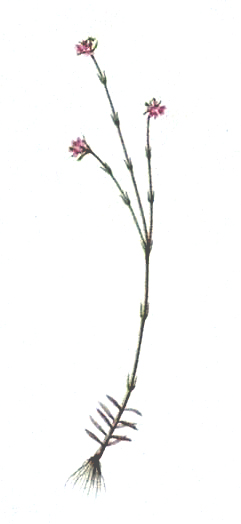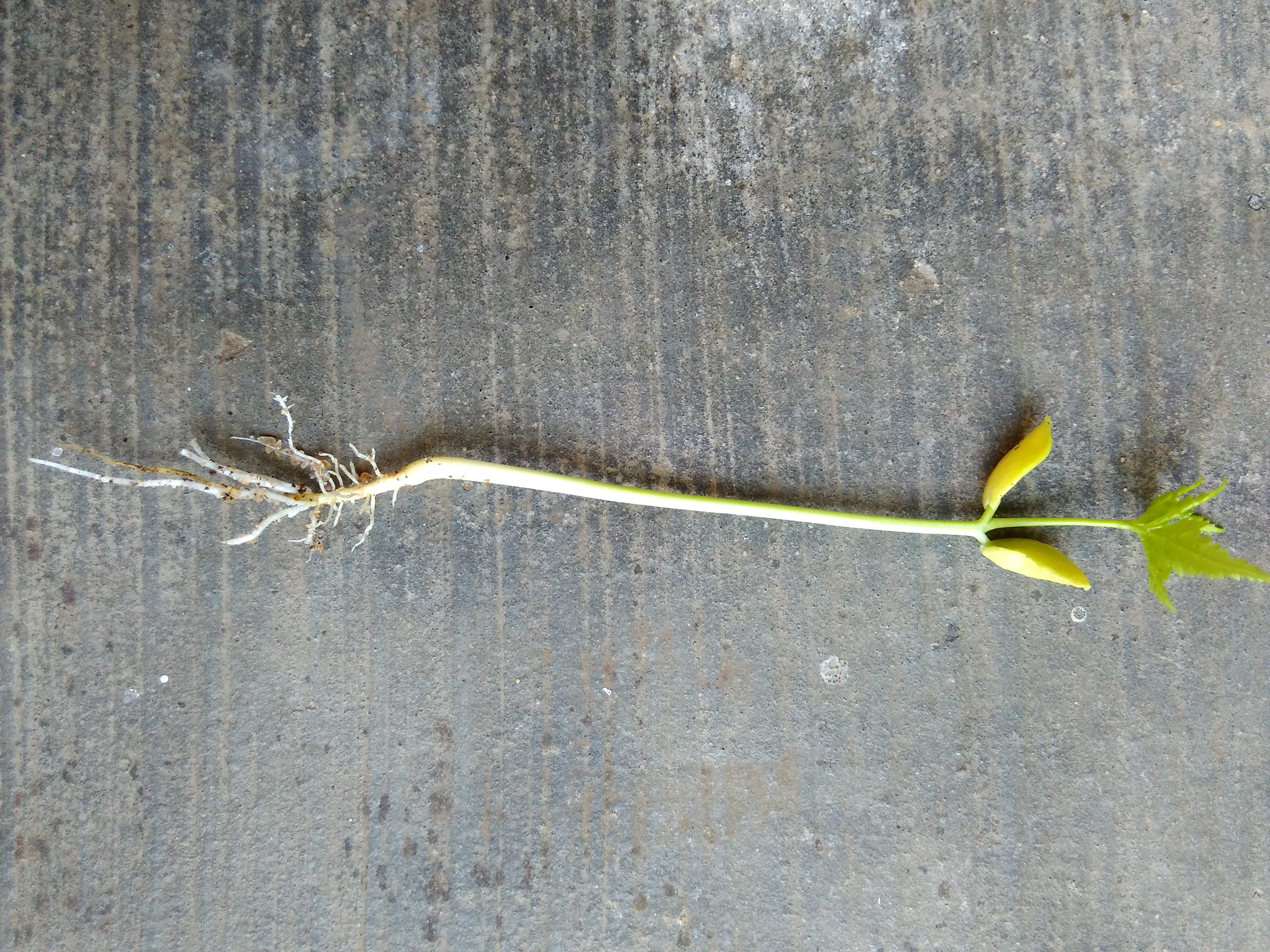|
Stylidium Fissilobum
''Stylidium fissilobum'' is a dicotyledonous plant that belongs to the genus ''Stylidium'' (family Stylidiaceae). It is an annual plant that grows from 5 to 50 cm tall. Linear or deltate leaves, about 4-34 per plant, are scattered along the elongate, glabrous stem. The leaves are generally 1–6 mm long and 0.3-0.7 mm wide. Petioles and scapes are absent. Inflorescences are 3–18 cm long. Flowers are pink, white, or mauve and bloom from March to July in the southern hemisphere. ''S. fissilobums wide distribution ranges across northern Australia from the western Kimberley region and Northern Territory eastward as far as Mount Surprise in Queensland. Its habitat is recorded as being wet sands at swamp edges in association with grasslands and sedgelands. Due to its weak stem, this species often threads its way through supporting branches and leaves of the dense grass and sedge cover. ''S. fissilobum'' is most closely related to '' S. aquaticum'' an ... [...More Info...] [...Related Items...] OR: [Wikipedia] [Google] [Baidu] |
Dicotyledon
The dicotyledons, also known as dicots (or, more rarely, dicotyls), are one of the two groups into which all the flowering plants (angiosperms) were formerly divided. The name refers to one of the typical characteristics of the group: namely, that the seed has two embryonic leaves or cotyledons. There are around 200,000 species within this group. The other group of flowering plants were called monocotyledons (or monocots), typically each having one cotyledon. Historically, these two groups formed the two divisions of the flowering plants. Largely from the 1990s onwards, molecular phylogenetic research confirmed what had already been suspected: that dicotyledons are not a group made up of all the descendants of a common ancestor (i.e., they are not a monophyletic group). Rather, a number of lineages, such as the magnoliids and groups now collectively known as the basal angiosperms, diverged earlier than the monocots did; in other words, monocots evolved from within th ... [...More Info...] [...Related Items...] OR: [Wikipedia] [Google] [Baidu] |
Mount Surprise, Queensland
Mount Surprise is a rural town and locality in the Shire of Etheridge, Queensland, Australia. In the , the locality of Mount Surprise had a population of 169 people. Geography The town is located in the Gulf Savannah in Far North Queensland on the Gulf Developmental Road, north west of the state capital, Brisbane and west of the regional centre of Cairns. History The town was founded by Ezra Firth, from the English county of Yorkshire, who along with his family settled in the area in 1864. The property struggled at first; relations with the indigenous inhabitants of the country were hostile and the country was not suited for wool growing. The discovery of gold in the 1880s and the subsequent gold rush allowed Firth to sell his sheep to the miners, convert his holding to cattle and become wealthy selling goods to the miners. In 1908, the Etheridge railway line reached Mount Surprise. Mount Surprise Post Office opened by July 1908. Mount Surprise State School op ... [...More Info...] [...Related Items...] OR: [Wikipedia] [Google] [Baidu] |
Plants Described In 1859
Plants are predominantly photosynthetic eukaryotes of the kingdom Plantae. Historically, the plant kingdom encompassed all living things that were not animals, and included algae and fungi; however, all current definitions of Plantae exclude the fungi and some algae, as well as the prokaryotes (the archaea and bacteria). By one definition, plants form the clade Viridiplantae (Latin name for "green plants") which is sister of the Glaucophyta, and consists of the green algae and Embryophyta (land plants). The latter includes the flowering plants, conifers and other gymnosperms, ferns and their allies, hornworts, liverworts, and mosses. Most plants are multicellular organisms. Green plants obtain most of their energy from sunlight via photosynthesis by primary chloroplasts that are derived from endosymbiosis with cyanobacteria. Their chloroplasts contain chlorophylls a and b, which gives them their green color. Some plants are parasitic or mycotrophic and have lost the abili ... [...More Info...] [...Related Items...] OR: [Wikipedia] [Google] [Baidu] |
Eudicots Of Western Australia
The eudicots, Eudicotidae, or eudicotyledons are a clade of flowering plants mainly characterized by having two seed leaves upon germination. The term derives from Dicotyledons. Traditionally they were called tricolpates or non- magnoliid dicots by previous authors. The botanical terms were introduced in 1991 by evolutionary botanist James A. Doyle and paleobotanist Carol L. Hotton to emphasize the later evolutionary divergence of tricolpate dicots from earlier, less specialized, dicots. Numerous familiar plants are eudicots, including many common food plants, trees, and ornamentals. Some common and familiar eudicots include sunflower, dandelion, forget-me-not, cabbage, apple, buttercup, maple, and macadamia. Most leafy trees of midlatitudes also belong to eudicots, with notable exceptions being magnolias and tulip trees which belong to magnoliids, and ''Ginkgo biloba'', which is not an angiosperm. Description The close relationships among flowering plants with tricolpat ... [...More Info...] [...Related Items...] OR: [Wikipedia] [Google] [Baidu] |
Flora Of The Northern Territory
''FloraNT'' is a public access web-based database of the Flora of the Northern Territory of Australia. It provides authoritative scientific information on some 4300 native taxa, including descriptions, maps, images, conservation status, nomenclatural details together with names used by various aboriginal groups. Alien taxa (over 470 species)Flora NT: Introduced species Retrieved 20 November 2018 are also recorded. Users can access fact sheets on species and some details of the specimens held in the Northern Territory Herbarium, (herbaria codes, NT, DNA) together with keys, and some regional factsheets. In the distribution guides FloraNT uses the version 5 ... [...More Info...] [...Related Items...] OR: [Wikipedia] [Google] [Baidu] |
Flora Of Queensland
Flora (: floras or florae) is all the plant life present in a particular region or time, generally the naturally occurring ( indigenous) native plants. The corresponding term for animals is ''fauna'', and for fungi, it is '' funga''. Sometimes bacteria and fungi are also referred to as flora as in the terms '' gut flora'' or '' skin flora''. Etymology The word "flora" comes from the Latin name of Flora, the goddess of plants, flowers, and fertility in Roman mythology. The technical term "flora" is then derived from a metonymy of this goddess at the end of the sixteenth century. It was first used in poetry to denote the natural vegetation of an area, but soon also assumed the meaning of a work cataloguing such vegetation. Moreover, "Flora" was used to refer to the flowers of an artificial garden in the seventeenth century. The distinction between vegetation (the general appearance of a community) and flora (the taxonomic composition of a community) was first made by Jules Thu ... [...More Info...] [...Related Items...] OR: [Wikipedia] [Google] [Baidu] |
Carnivorous Plants Of Australia
''Carnivorous Plants of Australia'' is a three-volume work on carnivorous plants by Allen Lowrie. The three tomes were published in 1987, 1989, and 1998, by University of Western Australia Press. An entirely updated three-volume work by Lowrie was published by Redfern Natural History Productions in December 2013 as ''Carnivorous Plants of Australia Magnum Opus''.Lowrie, A. 2013. ''Carnivorous Plants of Australia Magnum Opus - Volume Three''. Redfern Natural History Productions, Poole. . Content The first volume deals exclusively with tuberous sundews (genus ''Drosera''). The second is devoted to pygmy sundews, but also includes three tuberous species described since the publication of the first volume, as well as two other sundews that do not fit elsewhere ('' D. glanduligera'' and '' D. hamiltonii''). The final volume includes the remaining sundews of Australia, together with native species of ''Aldrovanda'', '' Byblis'', ''Cephalotus'', ''Nepenthes'', and ''Utricular ... [...More Info...] [...Related Items...] OR: [Wikipedia] [Google] [Baidu] |
List Of Stylidium Species
Discovery and description of new ''Stylidium'' species has been occurring since the late 18th century, the first of which was discovered in Botany Bay in 1770 and described by Joseph Banks and Daniel Solander. , a division of the Department of Environment and Conservation In the early 19th century, the French botanist [...More Info...] [...Related Items...] OR: [Wikipedia] [Google] [Baidu] |
Data Deficient
A data deficient (DD) species is one which has been categorized by the International Union for Conservation of Nature (IUCN) as offering insufficient information for a proper assessment of conservation status to be made. This does not necessarily indicate that the species has not been extensively studied; but it does indicate that little or no information is available on the abundance and distribution of the species. The IUCN recommends that care be taken to avoid classing species as "data deficient" when the absence of records may indicate dangerously low abundance: "If the range of a taxon is suspected to be relatively circumscribed, if a considerable period of time has elapsed since the last record of the taxon, threatened status may well be justified""The Categories," in IUCN (1983). (see also precautionary principle). See also * IUCN Red List data deficient species * List of data deficient amphibians As of January 2022, the International Union for Conservation of Nature ... [...More Info...] [...Related Items...] OR: [Wikipedia] [Google] [Baidu] |
Conservation Status
The conservation status of a group of organisms (for instance, a species) indicates whether the group still exists and how likely the group is to become extinct in the near future. Many factors are taken into account when assessing conservation status: not simply the number of individuals remaining, but the overall increase or decrease in the population over time, breeding success rates, and known threats. Various systems of conservation status exist and are in use at international, multi-country, national and local levels as well as for consumer use. International systems IUCN Red List of Threatened Species The IUCN Red List of Threatened Species is the best known worldwide conservation status listing and ranking system. Species are classified by the IUCN Red List into nine groups set through criteria such as rate of decline, population size, area of geographic distribution, and degree of population and distribution fragmentation. Also included are species that have gone e ... [...More Info...] [...Related Items...] OR: [Wikipedia] [Google] [Baidu] |
Stylidium Oviflorum
''Stylidium oviflorum'' is a dicotyledonous plant that belongs to the genus ''Stylidium'' (family Stylidiaceae). The specific epithet ''oviflorum'' comes from the Latin ''ovi'' meaning egg and ''florus'' meaning flower, which refers to this species flower colouration that resembles a fried egg with bright yellow and pure white colours. It is an annual plant that grows from 6 to 26 cm tall. The linear or deltate leaves, about 3-11 per plant, are scattered along the stem and are generally 1.4–3 mm long and 0.25-0.6 mm wide. Petioles and scapes are absent. Inflorescences are 4–15 cm long and produce white and yellow flowers that bloom from April to August in the southern hemisphere. ''S. oviflorum'' is endemic to the northern area of Queensland from Mareeba and Wairuna west to Barwidgi. Its habitat is recorded as being sandy soils in seepage areas, on hillsides, or beside creeks in the company of ''Melaleuca viridiflora'', ''Eucalyptus camaldulensi ... [...More Info...] [...Related Items...] OR: [Wikipedia] [Google] [Baidu] |
Stylidium Aquaticum
''Stylidium aquaticum'' is a dicotyledonous plant that belongs to the genus ''Stylidium'' (family Stylidiaceae). The specific epithet ''aquaticum'' refers to this species' typical habitat. It is an annual plant that grows from 18 to 30 cm tall. Linear leaves, about 20-100 per plant, are scattered along the elongate, glabrous stem. The leaves are generally 1.7–11 mm long and 0.1-0.3 mm wide. Petioles and scapes are absent. Inflorescences are 3–8 cm long. Flowers are pink or white. ''S. aquaticum'' is only known from its type location in northwestern Northern Territory of Australia. Its habitat is recorded as being a ''Melaleuca viridiflora'' swamp, growing in shallow water at a depth of around 7 cm. It flowers in the southern hemisphere in May. ''S. aquaticum'' is most closely related to '' S. fissilobum'' but differs mostly in the leaf shape. Its conservation status has been assessed as data deficient A data deficient (DD) species is one which ... [...More Info...] [...Related Items...] OR: [Wikipedia] [Google] [Baidu] |





